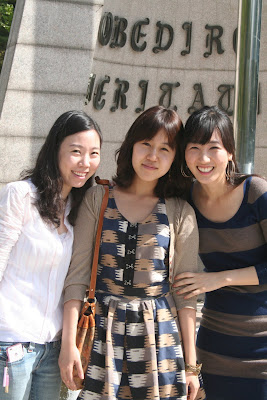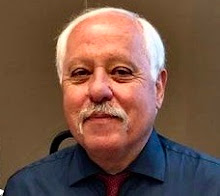 Returned last Wednesday from the Public Relations Society of America (PRSA) International Conference in San Diego from November 7-11 at the Marriott Hotel and Marina (above and below, left), where there was a variety of things to see and do. Some of it even had to do with the conference. Generally, I was there -- with apologies to L. Frank Baum, author of "The Wizard of Oz -- "to confer, converse and otherwise hobnob" with my fellow public relations practitioners.
Returned last Wednesday from the Public Relations Society of America (PRSA) International Conference in San Diego from November 7-11 at the Marriott Hotel and Marina (above and below, left), where there was a variety of things to see and do. Some of it even had to do with the conference. Generally, I was there -- with apologies to L. Frank Baum, author of "The Wizard of Oz -- "to confer, converse and otherwise hobnob" with my fellow public relations practitioners.Actually, however, a lot of it involved work as an assembly delegate representing the Greater Oregon Chapter of PRSA and the North Pacific District of PRSA, where I have served as chair for the last two years. The Greater Oregon Chapter of PRSA is my local chapter based in Eugene-Springfield, but includes members from as far away as Corvallis, Bend and Ashland. The North Pacific District has 16 chapters in eight states ranging from Alaska to Utah, and (as ZZ Top would sing) "all points in between."
The assembly itself is a cadre of PRSA leaders from the national board to chapter assembly delegates who collectively govern the society: a congress of leadership, if you will. And, as in the U.S. Congress, debate can be widely divergent and -- at times -- quite lively.
At times, the PRSA assembly reminds me of a scene from the John Ford classic "The Man Who Shot Liberty Valance," starring John Wayne, James Stewart and Lee Marvin: the nominating convention sequence in the Shinbone Saloon.
You know, wild and wooly.
Assembly is always a long day ranging in length from 8-10 hours depending on what's on the menu that particular year.
The year's assembly featured a complete rewrite of the society's bylaws, which were sorely outdated. From the start I expected trouble: the rabble rousers were out in force.
Before the conference, I received a long, rambling voicemail from Jack O'Dwyer, editor of a newsletter that focuses on public relations and marketing communications. O'Dwyer, a longtime thorn in the side of PRSA, described himself as a "reporter" who is "covering PRSA." "I want to help your cause, " he pleaded, noting that he is attempting to "stop the juggernaut."
"We're not going to hurt you" he added, which for some reason didn't sound very reassuring. Needless to say, I didn't return his call. Take a gander of the interview of Jack at the conference at http://www.propenmic.org/video/dna13-interviews-jack-odwyer.
A keynote speaker, Todd Buchholz (former White House director of economic policy) later referred to the "vigilante" concept in popular culture -- i.e. "Batman" and "Spiderman" -- when conventional leadership (cops) loses credibility with its constituents (citizens). O'Dwyer is a vigilante without a clue, and certainly no constituency.
But despite the potential for a verbal donnybrook at assembly, PRSA Chair Michael Cherinson and the national board -- with the help of a quality parliamentarian -- did a good job of keeping the discussion focused as we weathered a litany of amendments.
Surprisingly, the process was expeditious and -- though it was challenging for me to keep track of the UO-Stanford game on ESPN Gametracker with my iPhone -- we could have wrapped things up by 5 p.m. if it weren't for a few long-winded blow-hards and malcontents at the end. As it was, we adjourned at 6 p.m.
After assembly, I had dinner with a number of my colleagues from the North Pacific District PRSA at Roy's, a Hawaiian-themed restaurant.
 The rest of the conference focused on keynote speakers (this year's conference included Arianna Huffington of "The Huffington Post," one of the most successful news and opinion websites, and Buchholz), professional development seminars, vendor exhibition (where I enjoyed the lively strains of a delightful mariachi band, above), social activities and, of course, more meetings.
The rest of the conference focused on keynote speakers (this year's conference included Arianna Huffington of "The Huffington Post," one of the most successful news and opinion websites, and Buchholz), professional development seminars, vendor exhibition (where I enjoyed the lively strains of a delightful mariachi band, above), social activities and, of course, more meetings.The Public Relations Student Society of America (PRSSA) annually holds its conference in conjunction with the PRSA confab, so as professional advisor for the University of Oregon chapter, I hung out with five e-board members of that group, all former or current students of mine. We dined together on Saturday night at de'Medici's, an Italian restaurant in the Gaslamp Quarter of old San Diego.
 On Sunday, it was more meetings and sessions, followed by an extravaganza on the USS Midway, the longest-serving aircraft carrier of the 20th century. The ship is a floating museum, complete with flight simulators and other interactive displays and exhibits.
On Sunday, it was more meetings and sessions, followed by an extravaganza on the USS Midway, the longest-serving aircraft carrier of the 20th century. The ship is a floating museum, complete with flight simulators and other interactive displays and exhibits.At the dinner/social held on the flight deck of the massive ship, I reconnected with two former students now gainfully employed as public relations professionals.
On Monday, it was more professional development sessions, including a discussion of social media and how it applies to public relations. I believe that social media sites like My Space, Facebook and Twitter have true business applications, but it's still in the "wild west" stage of development, with more to come. It does have drawbacks. I like to say: "Welcome to My Face, where the seemingly significant can be significantly inane."
My last two days in San Diego were low key: I saw my niece, Nicole Mitchell (oldest daughter of my brother, Richard), a graduate student in speech therapy at San Diego State University, and generally enjoyed the sunshine while grading papers near the pool (below).
















































